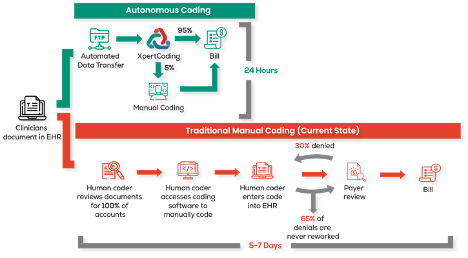Automation and artificial intelligence are buzzwords. You see these labels stamped on everything from vending machines to webcams. Often enough, these terms are just marketing ploys to sway buyers. When it comes to autonomous medical coding however, there is real artificially intelligent technology under the hood that results in a completely different process than manual medical coding.
What are the key differences between manual and autonomous medical coding processes?
Let’s dive in.
A brief recap of manual medical coding processes
Before we dig in, let’s review how manual medical coding processes generally work. First, a human coder reviews 100% of claims and accesses coding software to manually code. After reviewing the claims, the human coder translates the claims into a five-digit code into the Electronic Health Record (EHR) and sends the claims to the payer.
The payer reviews the claims and on average 30% of claims are denied and sent back to the coder. 65% of these denied claims are never reworked and represent lost revenue to practices. For the claims that are accepted, a bill is generated by the payer and payment is sent to the practice. The entire process takes, on average, 5-7 days.
A brief recap of autonomous medical coding process
On the autonomous medical coding side of things, we start with an automated data transfer from the clinical practice to the AI software. The artificial intelligence then autonomously codes 95% of claims without any human involvement and sends them to the payer for billing. The remaining 5% of claims that weren’t coded by the machine are handled by human coders, either employed by practices or autonomous coding vendors. Denials are rare, and when they occur they are immediately reanalyzed and recoded by the AI. The entire process takes less than 24 hours.

A Comparison of Manual vs. Autonomous Coding:
Now let’s compare manual and autonomous coding on what matters to practices: the results of coding. The biggest difference between autonomous medical coding and traditional manual coding processes is the time to code. As mentioned above, manual coding takes 5-7 days, while XpertCoding can code and submit claims within 24 hours. This reduced time-to-code increases runways and ensures that practices are paid promptly for services rendered, allowing practices the freedom to innovate, accelerate, and weather financial hardships.
Not only are claims coded quicker when autonomous coding solutions are used, but they are also coded more accurately. On average, autonomous coding implementation reduces denials by 30%. Furthermore, autonomous solutions are structured to automatically receive and code denied claims that are sent back by the payer. This is critical because 65% of denied claims are never revisited by manual coders, meaning that ~19.5% of claims (65% of the 30% of claims that are denied) are never appropriately coded and therefore never billed. Imagine a 19.5% increase in revenue and you are imagining the effects of autonomous medical coding.
On the cost side of the equation, autonomous medical coding offers cost structures that are both smaller in magnitude and more flexible. Rather than paying a team of medical coders a base salary that is constant regardless of patient flow, autonomous coding vendors often charge practices a flat cost-per-claim. The advantages of this cost model are two-fold.Low volume:
- When volume is lower than expected, practices are never over-charged. In an ideal manual medical coding system, a coding department will be overstaffed with coders so that they are prepared for any surges in patient demand. The result of this is wasted expense on extra coders that are often rarely needed. An AI solution eliminates this waste by charging a flat cost-per-claim, so that cost levels rise and fall proportionately with revenue.
- High volume: Practices are also able to seamlessly scale up when patient volume increases. Gone are the days of rushing to hire extra medical coders when volume increases or struggling to hire during The Great Resignation. Autonomous coding solutions handle high volumes with ease.
When practices grow and patient volume increases, autonomous coding seamlessly grows with it. When practices experience drops in patient volume, autonomous coding costs drop down with it. It is a system of perfect efficiency. It is an economist’s dream.
15% Off Medical Practice Supplies
VIEW ALL
 Manual Prescription Pad (Large - Yellow)
Manual Prescription Pad (Large - Yellow) Manual Prescription Pad (Large - Pink)
Manual Prescription Pad (Large - Pink) Manual Prescription Pads (Bright Orange)
Manual Prescription Pads (Bright Orange) Manual Prescription Pads (Light Pink)
Manual Prescription Pads (Light Pink) Manual Prescription Pads (Light Yellow)
Manual Prescription Pads (Light Yellow) Manual Prescription Pad (Large - Blue)
Manual Prescription Pad (Large - Blue)__________________________________________________
Appointment Reminder Cards
$44.05
15% Off
$56.30
15% Off
$44.05
15% Off
$44.05
15% Off
$56.30
15% Off













No comments:
Post a Comment